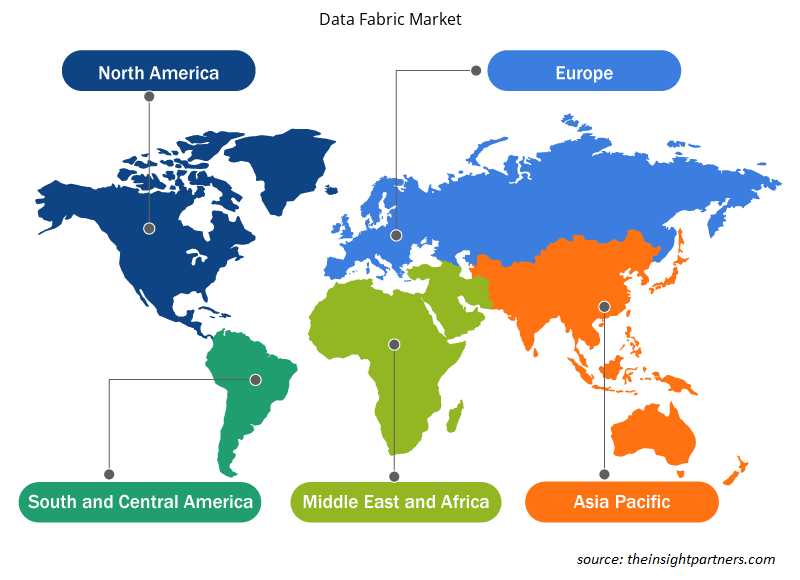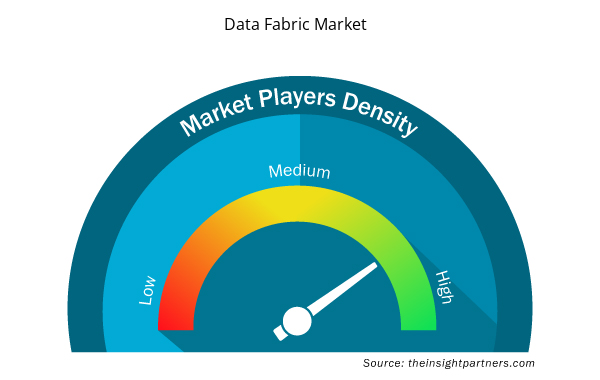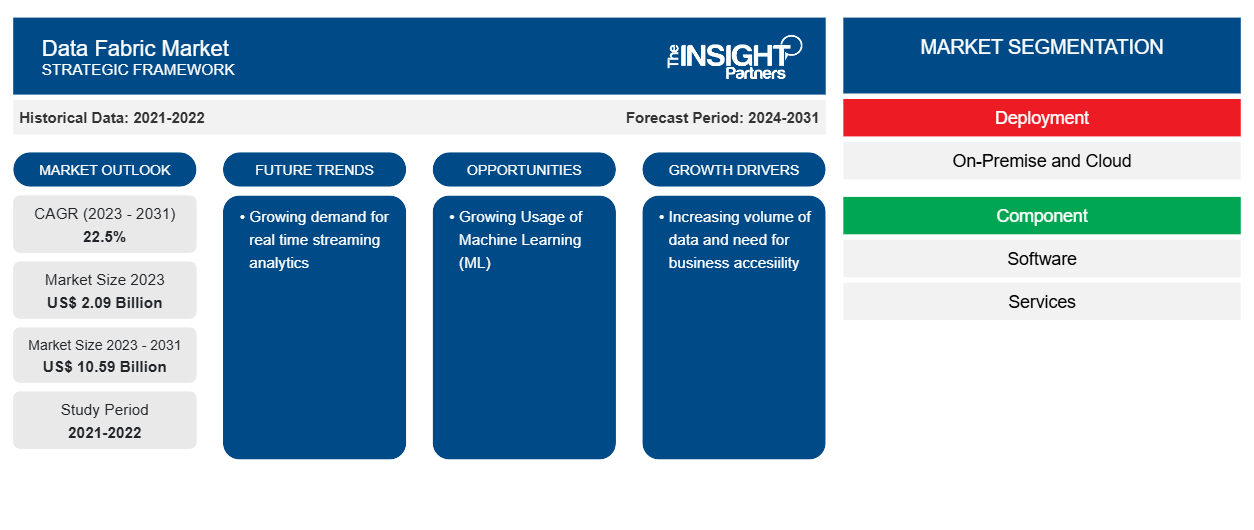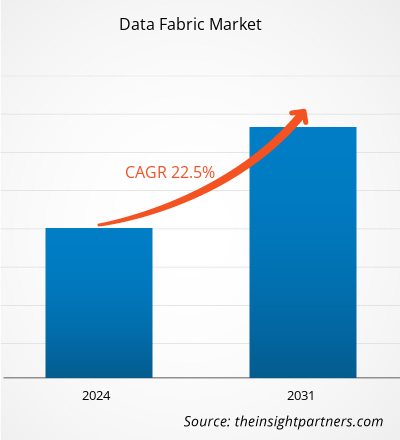Der Data Fabric-Markt soll von 2,09 Milliarden US-Dollar im Jahr 2023 auf 10,59 Milliarden US-Dollar im Jahr 2031 wachsen; von 2023 bis 2031 wird eine durchschnittliche jährliche Wachstumsrate von 22,5 % erwartet. Die steigende Nachfrage nach Echtzeit-Streaming-Analysen dürfte ein wichtiger Trend auf dem Markt sein.
Data Fabric-Marktanalyse
Das Data Fabric bietet Datenvirtualisierung, sodass Unternehmen nahtlosen Datenzugriff implementieren und diese gleichzeitig für alle zugänglich machen können. Durch die Implementierung des Data Fabric können Geschäftsbenutzer mit minimaler IT-Beteiligung auf Daten zugreifen, was zu einer schnelleren und einfacheren Umgebung für den Datenzugriff und -austausch führt. Ein gut konzipiertes logisches Data Fabric zentralisiert die grundlegende Sicherheit und Datenverwaltung. Daher wird erwartet, dass der Data Fabric-Markt im Prognosezeitraum wachsen wird.
Branchenübersicht zum Data Fabric-Markt
Data Fabric ist ein umfassendes Datenintegrations- und -verwaltungssystem, das Architektur , Datenverwaltungs- und Integrationstools sowie gemeinsam genutzte Daten umfasst, um Unternehmen bei der Verwaltung ihrer Daten zu unterstützen. Ein Data Fabric bietet eine einheitliche, konsistente Benutzererfahrung und Echtzeit-Datenzugriff für jedes Mitglied des globalen Netzwerks einer Organisation. Data Fabric soll Unternehmen bei der Lösung komplexer Datenprobleme und Anwendungsfälle unterstützen, indem es Daten über eine Vielzahl von Anwendungen, Plattformen und Standorten hinweg verwaltet. Data Fabric bietet reibungslosen Zugriff und Datenfreigabe in einer verteilten Datenumgebung.
Passen Sie diesen Bericht Ihren Anforderungen an
Sie erhalten kostenlos individuelle Anpassungen an jedem Bericht, einschließlich Teilen dieses Berichts oder einer Analyse auf Länderebene, eines Excel-Datenpakets sowie tolle Angebote und Rabatte für Start-ups und Universitäten.
- Holen Sie sich die wichtigsten Markttrends aus diesem Bericht.Dieses KOSTENLOSE Beispiel umfasst eine Datenanalyse von Markttrends bis hin zu Schätzungen und Prognosen.
Treiber und Chancen auf dem Data Fabric-Markt
Steigendes Datenvolumen fördert Marktwachstum
Jede datenzentrierte Organisation erfordert einen umfassenden Ansatz, der Zeit, Raum, verschiedene Softwaretypen und Datenstandorte berücksichtigt. Daten müssen für diejenigen verfügbar sein, die sie benötigen, und dürfen nicht hinter Firewalls versteckt oder über mehrere Orte verstreut sein. Unternehmen benötigen eine sichere, effiziente, konsistente und zukunftssichere Datenlösung, um ihre Betriebseffizienz zu verbessern. Daher wird erwartet, dass die Nachfrage nach Datenstrukturen im Prognosezeitraum steigen wird.
Zunehmende Nutzung von maschinellem Lernen (ML)
ML-Algorithmen können Datenpipelines überwachen und relevante Verknüpfungen und Integrationen vorschlagen . Diese Algorithmen extrahieren Informationen aus Daten, wenn sie mit der Datenstruktur verknüpft sind, überprüfen alle Geschäftsdaten und finden relevante Verknüpfungen und Korrelationen. Die Bereitstellung von Daten ist einer der zeitaufwändigsten Aspekte beim Trainieren eines ML-Modells. Das Data Fabric-Design macht ML-Modelle effizienter, indem es die Datenaufbereitungszeit verkürzt. Es verbessert auch die Nutzbarkeit aufbereiteter Daten in verschiedenen Anwendungen und Modellen. Unternehmen verteilen Daten vor Ort, in der Cloud und im IoT . Die Datenstruktur ermöglicht eingeschränkten Zugriff auf sichere Daten und verbessert ML-Prozesse. Daher wird erwartet, dass die Anwendung von ML in Data Fabric das Marktwachstum im Prognosezeitraum ankurbeln wird.
Datenstruktur
Marktbericht-Segmentierungsanalyse
Die wichtigsten Segmente, die zur Ableitung der Data Fabric-Marktanalyse beigetragen haben, sind die Abdeckung nach Bereitstellung, Komponente, Lösung und Endbenutzer.
- Nach Bereitstellung wird der Markt in On-Premise und Cloud unterteilt. Das Cloud-Segment führte den Markt im Jahr 2023 an.
- Basierend auf den Komponenten ist der Markt in Software und Dienstleistungen unterteilt
- Basierend auf der Lösung ist der Markt in Datenermittlung, Datenaufnahme, Datenorchestrierung, Fabric-Datenzugriff, Datenmanagement und Fabric-Management unterteilt und
- Auf der Grundlage der Endverbraucher ist der Markt in BFSI, IT und Telekommunikation, Einzelhandel, Gesundheitswesen und Pharmazeutika und andere unterteilt
Data Fabric-Marktanteilsanalyse nach geografischer Lage
Regional ist der Markt in Nordamerika, Europa, Asien-Pazifik, Naher Osten und Afrika sowie Süd- und Mittelamerika segmentiert.
Die nordamerikanische Region hatte im Jahr 2023 einen bedeutenden Anteil am Datenstrukturmarkt und wird im Prognosezeitraum voraussichtlich mit einer beträchtlichen durchschnittlichen jährlichen Wachstumsrate wachsen. Dieses Wachstum ist auf die Präsenz zahlreicher Marktteilnehmer und die frühzeitige Einführung technologischer Neuerungen zurückzuführen. Darüber hinaus wird erwartet, dass die Region Asien-Pazifik im Prognosezeitraum mit der höchsten durchschnittlichen jährlichen Wachstumsrate wächst. Dieses Wachstum ist auf die zunehmende Anzahl von Rechenzentren und die zunehmende Digitalisierung zurückzuführen.
Regionale Einblicke in den Data Fabric-Markt
Die regionalen Trends und Faktoren, die den Data Fabric-Markt im Prognosezeitraum beeinflussen, wurden von den Analysten von Insight Partners ausführlich erläutert. In diesem Abschnitt werden auch die Segmente und Geografien des Data Fabric-Marktes in Nordamerika, Europa, im asiatisch-pazifischen Raum, im Nahen Osten und Afrika sowie in Süd- und Mittelamerika erörtert.

- Erhalten Sie regionale Daten zum Data Fabric-Markt
Umfang des Data Fabric-Marktberichts
| Berichtsattribut | Details |
|---|---|
| Marktgröße im Jahr 2023 | 2,09 Milliarden US-Dollar |
| Marktgröße bis 2031 | 10,59 Milliarden US-Dollar |
| Globale CAGR (2023 - 2031) | 22,5 % |
| Historische Daten | 2021-2022 |
| Prognosezeitraum | 2024–2031 |
| Abgedeckte Segmente | Nach Bereitstellung
|
| Abgedeckte Regionen und Länder | Nordamerika
|
| Marktführer und wichtige Unternehmensprofile |
|
Marktteilnehmerdichte: Der Einfluss auf die Geschäftsdynamik
Der Data Fabric-Markt wächst rasant, angetrieben durch die steigende Nachfrage der Endnutzer aufgrund von Faktoren wie sich entwickelnden Verbraucherpräferenzen, technologischen Fortschritten und einem größeren Bewusstsein für die Vorteile des Produkts. Mit steigender Nachfrage erweitern Unternehmen ihr Angebot, entwickeln Innovationen, um die Bedürfnisse der Verbraucher zu erfüllen, und nutzen neue Trends, was das Marktwachstum weiter ankurbelt.
Die Marktteilnehmerdichte bezieht sich auf die Verteilung von Firmen oder Unternehmen, die in einem bestimmten Markt oder einer bestimmten Branche tätig sind. Sie gibt an, wie viele Wettbewerber (Marktteilnehmer) in einem bestimmten Marktraum im Verhältnis zu seiner Größe oder seinem gesamten Marktwert präsent sind.
Die wichtigsten auf dem Data Fabric-Markt tätigen Unternehmen sind:
- Denodo Technologies
- IBM Corporation
- Informatica Corporation
- K2Ansicht
- NetApp, Inc.
- Oracle Corporation
Haftungsausschluss : Die oben aufgeführten Unternehmen sind nicht in einer bestimmten Reihenfolge aufgeführt.

- Überblick über die wichtigsten Akteure auf dem Data Fabric-Markt
Neuigkeiten und aktuelle Entwicklungen zum Data Fabric-Markt
Der Data Fabric-Markt wird durch die Erhebung qualitativer und quantitativer Daten nach Primär- und Sekundärforschung bewertet, die wichtige Unternehmenspublikationen, Verbandsdaten und Datenbanken umfasst. Einige der Entwicklungen auf dem Data Fabric-Markt sind unten aufgeführt:
- LigaData, ein führender Anbieter im Bereich der Telekommunikationstechnologie, revolutioniert die Telekommunikations-Datenanalysebranche mit der Einführung seiner neuen Apps LigaData Telecom Data Fabric 4.0 und LigaData Telecom AI. Diese neuen Produkte unterstützen Telekommunikations- und Kommunikationsdienstleister bei ihren Initiativen, ihre Unternehmen von traditionellen Telekommunikationsunternehmen in agile, daten- und KI-gesteuerte Technologieunternehmen umzuwandeln und gleichzeitig das Umsatzwachstum voranzutreiben, Marktanteile zu halten und das Kundenerlebnis zu verbessern. (Quelle: LigaData, Pressemitteilung, Februar 2024)
Abdeckung und Ergebnisse des Data Fabric-Marktberichts
Die Data Fabric-Marktprognose wird auf der Grundlage verschiedener sekundärer und primärer Forschungsergebnisse geschätzt, wie z. B. wichtiger Unternehmensveröffentlichungen, Verbandsdaten und Datenbanken. Der Marktbericht „Data Fabric-Marktgröße und -prognose (2021–2031)“ bietet eine detaillierte Analyse des Marktes, die die folgenden Bereiche abdeckt:
- Data Fabric-Marktgröße und -prognose auf globaler, regionaler und Länderebene für alle wichtigen Marktsegmente, die im Rahmen des Berichts abgedeckt sind
- Data Fabric-Markttrends sowie Marktdynamik wie Treiber, Einschränkungen und wichtige Chancen
- Detaillierte PEST/Porters Five Forces- und SWOT-Analyse
- Data Fabric-Marktanalyse mit wichtigen Markttrends, globalen und regionalen Rahmenbedingungen, wichtigen Akteuren, Vorschriften und aktuellen Marktentwicklungen
- Branchenlandschaft und Wettbewerbsanalyse, die die Marktkonzentration, Heatmap-Analyse, prominente Akteure und aktuelle Entwicklungen auf dem Data Fabric-Markt umfasst
- Detaillierte Firmenprofile.
- Historische Analyse (2 Jahre), Basisjahr, Prognose (7 Jahre) mit CAGR
- PEST- und SWOT-Analyse
- Marktgröße Wert/Volumen – Global, Regional, Land
- Branche und Wettbewerbsumfeld
- Excel-Datensatz



Report Coverage
Revenue forecast, Company Analysis, Industry landscape, Growth factors, and Trends

Segment Covered
This text is related
to segments covered.

Regional Scope
North America, Europe, Asia Pacific, Middle East & Africa, South & Central America

Country Scope
This text is related
to country scope.
Häufig gestellte Fragen
The global Data Fabric market was estimated to grow at a CAGR of 22.5% during 2023 - 2031.
Growing demand for real-time streaming analytics is the major trend in the market.
The report can be delivered in PDF/PPT format; we can also share an Excel dataset based on the request.
Denodo Technologies, IBM Corporation, Informatica Corporation, K2View, NetApp, Inc., Oracle Corporation, SAP SE, Software AG, Teradata, and Hewlett Packard Enterprise Development LP (HPE) are the major market players.
Some of the customization options available based on the request are additional 3–5 company profiles and a country-specific analysis of 3–5 countries of your choice. Customizations are to be requested/discussed before making final order confirmation, as our team would review the same and check the feasibility.
The increasing volume of data and the need for business accessibility are the major factors that drive the global Data Fabric market.
Trends and growth analysis reports related to Technology, Media and Telecommunications : READ MORE..
The Insight Partners performs research in 4 major stages: Data Collection & Secondary Research, Primary Research, Data Analysis and Data Triangulation & Final Review.
- Data Collection and Secondary Research:
As a market research and consulting firm operating from a decade, we have published and advised several client across the globe. First step for any study will start with an assessment of currently available data and insights from existing reports. Further, historical and current market information is collected from Investor Presentations, Annual Reports, SEC Filings, etc., and other information related to company’s performance and market positioning are gathered from Paid Databases (Factiva, Hoovers, and Reuters) and various other publications available in public domain.
Several associations trade associates, technical forums, institutes, societies and organization are accessed to gain technical as well as market related insights through their publications such as research papers, blogs and press releases related to the studies are referred to get cues about the market. Further, white papers, journals, magazines, and other news articles published in last 3 years are scrutinized and analyzed to understand the current market trends.
- Primary Research:
The primarily interview analysis comprise of data obtained from industry participants interview and answers to survey questions gathered by in-house primary team.
For primary research, interviews are conducted with industry experts/CEOs/Marketing Managers/VPs/Subject Matter Experts from both demand and supply side to get a 360-degree view of the market. The primary team conducts several interviews based on the complexity of the markets to understand the various market trends and dynamics which makes research more credible and precise.
A typical research interview fulfils the following functions:
- Provides first-hand information on the market size, market trends, growth trends, competitive landscape, and outlook
- Validates and strengthens in-house secondary research findings
- Develops the analysis team’s expertise and market understanding
Primary research involves email interactions and telephone interviews for each market, category, segment, and sub-segment across geographies. The participants who typically take part in such a process include, but are not limited to:
- Industry participants: VPs, business development managers, market intelligence managers and national sales managers
- Outside experts: Valuation experts, research analysts and key opinion leaders specializing in the electronics and semiconductor industry.
Below is the breakup of our primary respondents by company, designation, and region:

Once we receive the confirmation from primary research sources or primary respondents, we finalize the base year market estimation and forecast the data as per the macroeconomic and microeconomic factors assessed during data collection.
- Data Analysis:
Once data is validated through both secondary as well as primary respondents, we finalize the market estimations by hypothesis formulation and factor analysis at regional and country level.
- Macro-Economic Factor Analysis:
We analyse macroeconomic indicators such the gross domestic product (GDP), increase in the demand for goods and services across industries, technological advancement, regional economic growth, governmental policies, the influence of COVID-19, PEST analysis, and other aspects. This analysis aids in setting benchmarks for various nations/regions and approximating market splits. Additionally, the general trend of the aforementioned components aid in determining the market's development possibilities.
- Country Level Data:
Various factors that are especially aligned to the country are taken into account to determine the market size for a certain area and country, including the presence of vendors, such as headquarters and offices, the country's GDP, demand patterns, and industry growth. To comprehend the market dynamics for the nation, a number of growth variables, inhibitors, application areas, and current market trends are researched. The aforementioned elements aid in determining the country's overall market's growth potential.
- Company Profile:
The “Table of Contents” is formulated by listing and analyzing more than 25 - 30 companies operating in the market ecosystem across geographies. However, we profile only 10 companies as a standard practice in our syndicate reports. These 10 companies comprise leading, emerging, and regional players. Nonetheless, our analysis is not restricted to the 10 listed companies, we also analyze other companies present in the market to develop a holistic view and understand the prevailing trends. The “Company Profiles” section in the report covers key facts, business description, products & services, financial information, SWOT analysis, and key developments. The financial information presented is extracted from the annual reports and official documents of the publicly listed companies. Upon collecting the information for the sections of respective companies, we verify them via various primary sources and then compile the data in respective company profiles. The company level information helps us in deriving the base number as well as in forecasting the market size.
- Developing Base Number:
Aggregation of sales statistics (2020-2022) and macro-economic factor, and other secondary and primary research insights are utilized to arrive at base number and related market shares for 2022. The data gaps are identified in this step and relevant market data is analyzed, collected from paid primary interviews or databases. On finalizing the base year market size, forecasts are developed on the basis of macro-economic, industry and market growth factors and company level analysis.
- Data Triangulation and Final Review:
The market findings and base year market size calculations are validated from supply as well as demand side. Demand side validations are based on macro-economic factor analysis and benchmarks for respective regions and countries. In case of supply side validations, revenues of major companies are estimated (in case not available) based on industry benchmark, approximate number of employees, product portfolio, and primary interviews revenues are gathered. Further revenue from target product/service segment is assessed to avoid overshooting of market statistics. In case of heavy deviations between supply and demand side values, all thes steps are repeated to achieve synchronization.
We follow an iterative model, wherein we share our research findings with Subject Matter Experts (SME’s) and Key Opinion Leaders (KOLs) until consensus view of the market is not formulated – this model negates any drastic deviation in the opinions of experts. Only validated and universally acceptable research findings are quoted in our reports.
We have important check points that we use to validate our research findings – which we call – data triangulation, where we validate the information, we generate from secondary sources with primary interviews and then we re-validate with our internal data bases and Subject matter experts. This comprehensive model enables us to deliver high quality, reliable data in shortest possible time.


 Holen Sie sich ein kostenloses Muster für diesen Bericht
Holen Sie sich ein kostenloses Muster für diesen Bericht